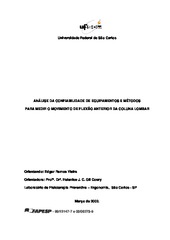Análise da confiabilidade de equipamentos e métodos para medir o movimento de flexão anterior da coluna lombar
Abstract
Current high incidence of low back pain represents high costs to patients,
industries, health insurance companies and government. Moreover, it causes loss
in life quality of suffers. Lumbar flexion movement is critical to the development
and aggravation of low back pain. Thus, quantification of this movement is
important to the prevention and treatment of these disorders. Therefore, the
purposes of this research were: design two new methods to quantify lumbar
flexion movement, improve electrogoniometer interfaces, and assess the reliability
of three devices and methods to measure the studied movement. In order to
achieve these objectives, three studies were designed. Study 1 has compared the
measurements from an electrogoniometer fixed by Attachment Ducts (ADs), with
those from another electrogoniometer without ADs, and the measurements of both
electrogoniometers with those from a high precision goniometer. Study 2 has
compared both conditions studied previously, when the electrogoniometers were
fixed in parallel on lumbar muscles of 14 subjects. Study 3 presented the
Perpendicular Markers Photometric Technique (PMPT) and the Distanciometer,
both designed for this study. Furthermore, this study analyzed the reliability of the
PMPT, fleximeters (usually known as inclinometers), and Distanciometer, when
compared to the measurements of lumbar flexion movement of 25 subjects
performed by an electrogoniometer. Results indicated that electrogoniometers are
precise equipment, ADs did not influence measurements and provided a more
specific definition of the region to be assessed by electrogoniometers, and high
reliability was found for both PMPT and Distanciometer, but not for the fleximeters
used in this study.
